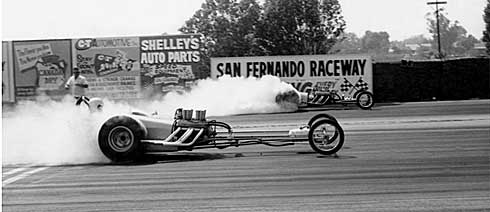
Good Traction vs. Good Racing
6/8/06
 rag racers demand and deserve decent traction and trustworthy clocks. Personal experience on track crews taught me that a good starting line and an accurate timing system are the most-critical ingredients to decent weekly car counts at a typical drag strip (not to be confused with a major-league facility that hosts IHRA or NHRA events). The sportsman racers whose support either makes or breaks every small track will put up with just about anything — smelly outhouses; unpaved pits; rude personnel; snack-bar salmonella — if you’ll just give them enough bite to make the most of their combinations, timewise.
rag racers demand and deserve decent traction and trustworthy clocks. Personal experience on track crews taught me that a good starting line and an accurate timing system are the most-critical ingredients to decent weekly car counts at a typical drag strip (not to be confused with a major-league facility that hosts IHRA or NHRA events). The sportsman racers whose support either makes or breaks every small track will put up with just about anything — smelly outhouses; unpaved pits; rude personnel; snack-bar salmonella — if you’ll just give them enough bite to make the most of their combinations, timewise.
Don Prudhomme was the first person I ever heard say, “E.T. cures everything!” That was back in the ’70s, and nothing has changed. Give a racer a time slip showing a career-best elapsed time or reaction time and all grievances are forgotten, at least until the next event.
Traction, that long-elusive ingredient, has become the double-edged sword of drag racing. Ever since performance reached that point at which alarmed rule-makers started imposing various electronic, mechanical and chemical “throttle stops” onto all forms of fuel cars (including nostalgia and injected NHRA dragsters), I’ve been wondering whether we now have too much of a good thing.
It’s taken nearly four decades for Top Fuelers to advance from ferociously boiling the baloneys through the lights to literally breaking apart in the lights, under the combined loads produced by modern aerodynamics, tires and track preparation. Responding to the recent controversy surrounding the “weepers” that forced cancellation of Famoso (Calif.) Raceway’s March Meet, Wayne King — a Bakersfield boy who started driving dragsters in 1957 — remembered, “That water deal ain’t nothin’ new. We used to drive around the wet spots, back in the day.”

Prior to mid-Sixties tire advances, unblown fuel motors bigger than 310 inches ran Top Fuel. The author’s all-time-favorite “giant-killer” was the Accessories Limited B/FD. Here, pilot Bob Noice leaves on the Freeman & Sons C/Fueler. (HotRodNostalgia.com photo ©Dave Wallace Sr.)
Indeed, the outcome of the inaugural (1959) edition was altered when Tony Waters hit some water and spun out while leading the Top Eliminator final, enabling Art Chrisman to drive by for a historic win. In March 1965, that same surface was so slick that many Top Fuel racers considered going home, until the late Jack Williams, the event director, convinced them that, because both lanes were equally wet, nobody would have an
advantage. Everyone raced!Four decades down the road, anything less than “national-event conditions” seems unacceptable to a whole generation of pro and “professional sportsman” racers. More than one graduate of some “instant-hero” (i.e., driving) school may have never turned a tire on anything but 1320 feet of meticulously-maintained race track, laser-ground to within a fraction of an inch of flatness and coated with enough glue to suck your sneakers off your feet. This spoiled individual is unlikely to be seen at the vast majority of drag strips in the land, where traction is unpredictable and inconsistent, even from lane to lane.